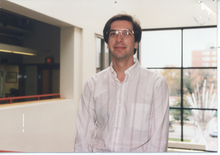
Emeritus
Research Interests:
Electroweak Symmetry Breaking
My research examines important problems in understanding the fundamental particles and fields that make up the physics universe. The breakdown of electroweak and flavor symmetries are among the most pressing problems facing particle physics today. Electroweak symmetry breaking is manifested by the non-zero masses of the weak W and Z bosons, and requires the existence of a Higgs boson or some other yet unseen mechanism. Several theoretical approaches to electroweak and flavor symmetry breaking, as well as the related question of CP violation, are actively being investigated. Many of the questions of current theoretical interest are beyond the energy reach of existing accelerators. However, extremely high energies were once realized in the largest natural particle accelerator, the Big Bang. Shortly after the Big Bang, the universe was composed of a hot plasma of elementary particles. The nature of this plasma, which depends on the properties of the constituent elementary particles, determined the subsequent evolution of the universe. By observing the universe today, we can obtain information about its state shortly after the Big Bang and obtain information about the interactions of these particles at high energy. Several cosmological problems are presently being considered, among them: Is there a consistent inflationary model of the early universe? What is the nature of dark matter and what role does it play in the development of large-scale structure? What mechanism produced the baryon excess in the universe?
Selected Publications:
“Pair creation constrains superluminal neutrino propagation”, A. G. Cohen and S. L. Glashow, Phys. Rev. Lett. 107, 181803 (2011)
“Disentangling neutrino oscillations”, A. G. Cohen, S. L. Glashow, and Z. Ligeti, Phys. Lett. B 678, 191–196 (2009)
“Hidden sector renormalization of MSSM scalar masses”, A. G. Cohen, T. S. Roy, and M. Schmaltz, JHEP 02, 027 (2007)
“Very special relativity”, A. G. Cohen and S. L. Glashow, Phys. Rev. Lett. 97, 021601 (2006)
“Supersymmetry on a Euclidean space-time lattice. 2. Target theories with eight supercharges”, A. G. Cohen, D. B. Kaplan, E. Katz, and M. Unsal, JHEP 12, 031 (2003)
For a full list of publications, please see the attached CV.
Honors/Awards:
- Fellow of the American Physical Society
- Boston University Gitner Award for Teaching Excellence (2000)
- DOE Outstanding Junior Investigator (1991)
In the news:
Research Descriptions:
Electroweak Symmetry Breaking
The problems of the breakdown of electroweak and flavor symmetries are among the most pressing facing particle physics today. Electroweak symmetry breaking is manifested by the nonzero masses of the weak W and Z bosons, and requires the existence of a Higgs boson or some other yet unseen mechanism. To solve the problem of flavor, one must understand why there are six quarks and six leptons forming three families, and why these particles exhibit such a peculiar pattern of masses and mixing. This question has become especially acute with the recent experimental proof that neutrinos have mass and experience oscillations. Several theoretical approaches to electroweak and flavor symmetry breaking, as well as the related question of CP violation, are being investigated actively. All of them require that there be new particles and new interactions at soon-to-be accessible energies. In particular, experiments at the Large Hadron Collider are currently accumulating data which should clarify the origins of electroweak symmetry breaking. The high-energy theorists are interacting closely with their experimental colleagues who will be working on these experiments. Research is aimed at formulating consistent theoretical models and exploring their observable consequences.
The Big Bang, Dark Matter, and Cosmology
Many of the questions of current theoretical interest are beyond the energy reach of existing accelerators. However, extremely high energies were once realized in the largest natural particle accelerator, the Big Bang. Shortly after the Big Bang, the universe was composed of a hot plasma of elementary particles. The nature of this plasma, which depends on the properties of the constituent elementary particles, determined the subsequent evolution of the universe. By observing the universe today, we can obtain information about its state shortly after the Big Bang and obtain information about the interactions of these particles at high energy. Several cosmological problems are presently being considered, among them: Is there a consistent inflationary model of the early universe? What is the nature of “dark matter” and what role does it play in the development of large-scale structure? What mechanism produced the baryon excess in the universe?